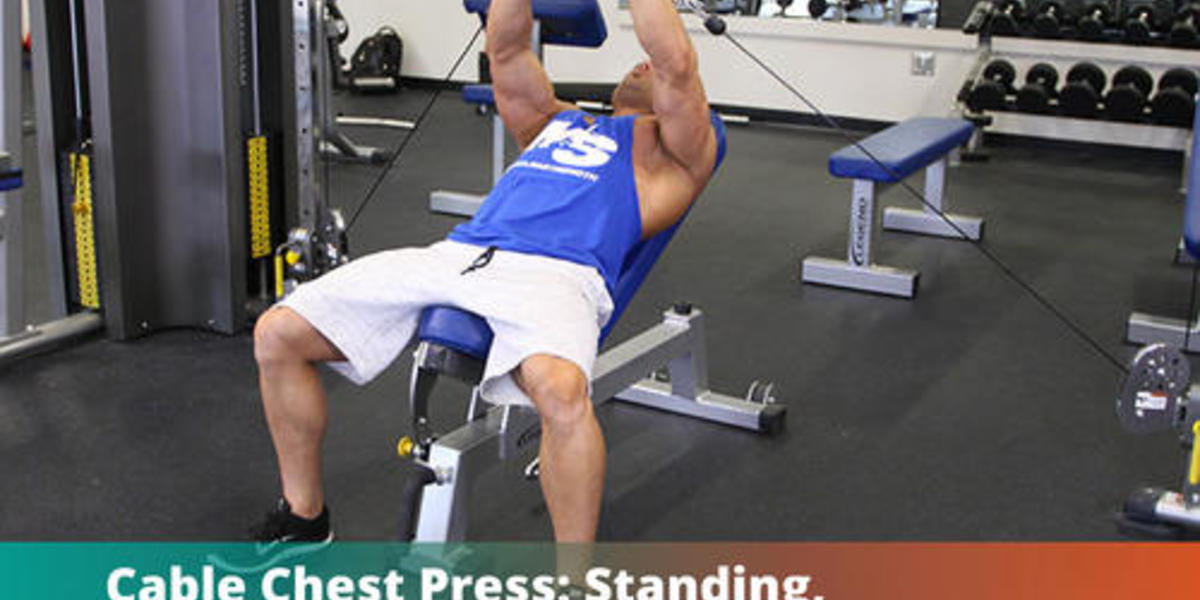Cable Chest Press: Standing, Seated, Incline, Decline (VIDEOS)
The cable chest press is a great alternative exercise to the bench press or cable crossover and is very easy to implement into your next workout.
In this article we will show you how to do the cable chest press and variations including:
Standing cable chest press
Single-arm cable chest press
Seated Cable Chest Press
Cable chest press with dumbbells
Incline Cable Chest Press (Seated)
3 Variations of Decline Cable Chest Press
But first, if you want to pursue a financially-rewarding fitness job, enquire about our CIMSPA-accredited personal trainer diploma below or download our course prospectus to learn more.
Start a Successful Online PT Business From Home in 9 Weeks!
Get started by downloading our video guide
Standing Cable Chest Press
Set Up: For this exercise you can either use a cable chest press machine or the cable crossover, they both adhere to the same functionality. Set-up the pulleys so that the stirrups (handles) are at hip to chest height.
Starting Position:
- Stand in the centre of the two pulleys and grip the stirrups one hand at a time.
- Step forward a couple of foot in front of the cable machine with one leg in front of the other to from a staggered stance. Your back foot may go onto tip toes, but keep your front foot planted on the floor.
- When repeating the standing cable chest press, it is advisable to reverse the forward leg with your back leg on the next set.
- Retract you shoulder blades together and adjust your arms to a 90-degree angle.
Execution:
- Before contracting, ensure your head is up, core is engaged, and the rest of your body is stable and stationary.
- Move the handles forward through extending via your elbows, until your hands meet in the centre.
- Briefly squeeze before slowly managing the eccentric contraction phase back to the starting position.
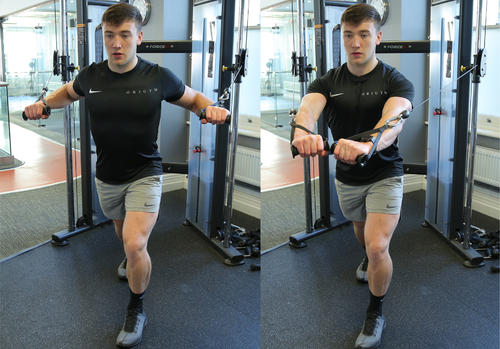
Grips : To place extra emphasis onto your triceps and inner chest (sternal head of the pec major) take a slightly narrower stance / grip. To place more emphasis on the wider part of your chest, take a slightly wider stance / grip.
Standing Cable Chest Press Muscles worked:
Prime Mover: pectoralis major (chest)
Secondary Muscles: Anterior Deltoid (front of shoulder), Triceps brachii (back of arm)
Common mistakes with the standing cable chest press to avoid:
- Leaning forward – Leaning forward into the movement is detrimental to both balance and isolation of the pectoral.
- Hand Grip – Your palms should not be facing the direction you’re pushing, instead facing the floor. This alleviates the pressure off your forearms onto your pecs.
Standing Cable Chest Benefits:
- Unlike a standard bench press where you’re lying on your back, which limits the cores involvement, the standing bench press engages your core and stabiliser muscles far more as you are having to control every angle that the weight can potentially move in.
- Another standing cable chest benefit to the convention bench press is that you can increase the range of motion to where your hands meet (or cross). With a flat bench press you can only go about 60 degrees and with dumbbells only a little bit further.
Become a Personal Trainer with OriGym!
- Qualify & start earning in just 2 weeks
- Study full-time, part-time or online
- Endorsed by CIMSPA
Cable Single-Arm Chest Press (Standing)
The cable single-arm chest press is a recommended movement for isolating the chest, especially for muscular imbalances, postural improvement, increased range of motion (ROM) and getting the core more involved in the execution of the movement.
Set Up:
Using the cable crossover machine or if your gym has a cable chest press, set the pulleys on both sides to hip to chest height.
Starting Position:
- To get into the starting position, grab one of the handles and step forward into a lunge position. One foot in front of the other with both legs bent, feet facing forward. Step forward until you have full tension of the weight.
- Ensure your front forward is firmly placed on the floor and your back foot can go onto tip toes for support.
- Keep your hand in a supinated position (palm facing down) and the stirrup close to your chest (shoulder width stance).
- Place your opposite arm out in front of you at chest height to help counter the weight.
- If you’re a beginner, place the same weight on the opposite pulley and keep then tension at the shoulder width stance. This will reduce core engagement but assist with balance and help you perfect the movement.
Execution:
- Keeping your back straight and head up, drive forward from the chest through your elbows.
- As you push forward, allow your shoulder to roll and bring the opposite arm back allowing your body to rotate into the movement a little.
- As you lower the weight back to the starting position, your arm opposite arm will extend back out in front of you.
- Repeat the movement on the opposite side.
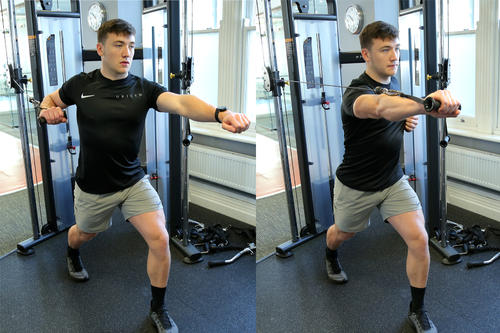
Single Arm Cable Chest Press Muscles worked:
Prime Mover: pectoralis major
Secondary Muscles Worked: Anterior Deltoid (front of shoulder), Triceps brachii (back of arm)
Common Mistakes to avoid:
- Trying to Save Time – Often gym users will perform the cable single arm chest press by holding both the handles in each hand and then rotating reps between each side. Even with perfect form, this loses the many of the benefits of doing the exercise unilaterally and can be very difficult to balance when executing each rep.
- Back Alignment – When trying to lift heavy weights with this exercise, one of the challenges is to keep that core tight and back in the correct neutral position. Leaning too far forward or not engaing thre core can cause the back to bend and cause injury.
Seated Cable Chest Press
The cable chest press can be performed in a seated position.
Set Up: For the seated cable chest press you can either harness the cable crossover or cable chest press machine, depending on what is available to you in your gym. Position a bench in between the two pulleys with the handles about roughly chest height.
Starting Position:
- Grip the stirrups with a pronated grip (knuckles facing the direction you’re pushing).
- Keep your back tight against the bench and positon your arms to be aligned with your wrists to keep the movement flowing from your elbows.
Execution:
- Keeping the rest of your body stationary, extend your elbows ensuring you’re pressing from the mid chest area.
- You can either stop when the hands meet or cross at the end of the movement and squeeze. Try not to lock the elbows at the top of the movement.
- Slowly control the cables on the release without allowing the weight to rest.
- Remember to inhale on the release and exhale when contracting.
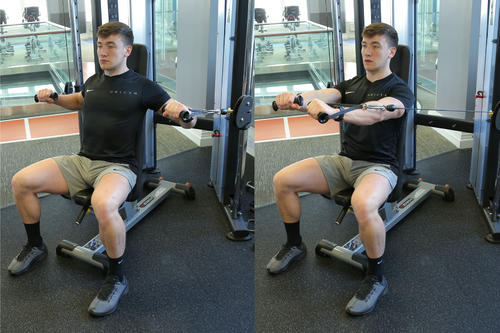
Seated Cable Chest Press Muscles worked:
Prime Mover: pectoralis major (Chest)
Secondary Muscles: Anterior Deltoid (front of the shoulder, Triceps brachii (back of the arm)
Mistakes to avoid with the seated cable chest press:
Start a Successful Online PT Business From Home in 9 Weeks!
Get started by downloading our video guide
Incline Cable Chest Press
Set Up: With the incline cable press, place a bench in the middle of two low pulleys at a 45 degree angle with the pulleys at the bottom of the cable crossover station. Ensure the bench is positioned so that when you grab the handles the resistance is in line with your chest.
Starting Position:
- Grab one handle (or both if you can) with a supine grip and place your back firmly against the bench and feet planted on the floor, slightly wider than shoulder width apart.
- Position the stirrups at the side of your chest, tucked in a little with a 90-degree flexion (bend) in your arms.
Execution:
- Exhale as you extend your elbows up to move your arms up and inwards until your hand meet.
- Squeeze your chest at the top of the movement and then inhale as you slowly release back to the starting position.
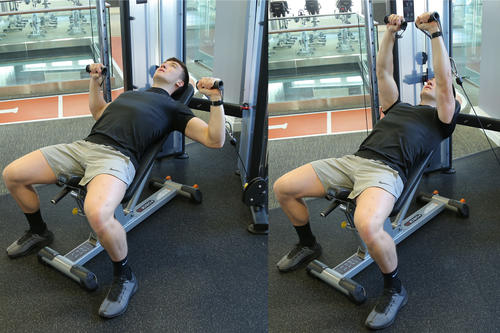
Incline cable chest press Muscles worked:
Prime Mover: Clavicular (Upper Head) Pectoralis Major (Chest)
Secondary Muscle: Triceps brachii (back of the arms), Anterior Deltoid (front of the shoulder)
Mistakes to avoid:
- Bench Positioning – Sounds silly, but this is one of the most common mistakes when executing the incline cable press. If you position the bench too far back or in front of the pulleys you will shift the resistance away from your pec major.
- Elbow Starting Position – Placing the elbows at a 90-degree angle is optimal for this exercise. Try to avoid letting your elbows drop when executing the movement.
Seated Cable Chest Press (Dumbbells)
The dumbbell cable press for chest has many variations, which you can see below, and is an underused commodity for most gym goers. It is very useful if you do not have a spotter when performing the standard dumbbell press as it provides more resistance throughout the whole movement and is easier to control and execute safely.
Set Up:
- You can use ankle harnesses, straps or cables that attach directly to the dumbbell.
- You will need a bench and of course appropriate sized dumbbells.
- Place the bench in the middle of the cable crossover machine. Fasten your straps to your wrists, then attach them to the lower pulleys on each side. Ensure you have picked low to medium weights on both the stack and dumbbells when new to this movement as it can take some time to adjust to.
Starting Position:
- Start by lying supine on the bench (face up) and feet flat on the floor
- Pick up the dumbbells and place them on either side of your chest with palms facing forwards.
- Contract your abdominals in and tilt your chin toward your chest.
Execution:
- Push the dumbbells up from your chest to your arms are almost fully extended, but not to the point of your elbows locking.
- Make sure you take a big breath in during release and big breathe out when contracting.

Muscles worked:
Prime Mover: pectoralis major (chest)
Secondary Muscle: Triceps brachii (back of the arms), Anterior Deltoid (front of the shoulder)
Common Mistakes to avoid:
- Shoulders rising off the bench
- Palms facing directly up and not forward. This places extra strain on the joint at your wrist and off the pectoralis major.
- Locking elbows at the top of the movement, which allows the muscles to rest.
- Setting up the cable crossover machine too high which leads to the back arching and taking emphasis away from the chest and onto the shoulders or starts turning the movement into a cable crossover.
- Not placing the arms at a 90-degree angle.
You can also repeat the movement for both decline and incline chest press single armed or with dumbbells.
Decline Cable Press (Standing)
The standing decline cable press follows the same pattern as the normal cable chest press, but this will target more of the lower pectoralis major head.
Set Up:
Starting Position: Position the cable stirrups at the highest point or if you’re small, slightly lower down.
- Stand in the middle of the cable crossover, stepping back to grip one handle at a time.
- Holding the handles in a supine grip, move them it towards you’re your lower chest / upper midriff with elbows at a 90-degree angle.
- Take a couple of steps forward in front of the apparatus and take the tension of the weight.
Execution:
- Keeping your core engaged and head up take a big breath out as you drive through your elbows out and in a slightly downward motion
- When the stirrups meet in the middle in front of your midriff, squeeze the contraction and then slowly control the movement to back to the starting position.
Decline Cable Press Muscles worked:
Prime Mover: Sternal head - Pectoralis Major
Secondary Muscle: Triceps brachii, Anterior Deltoid
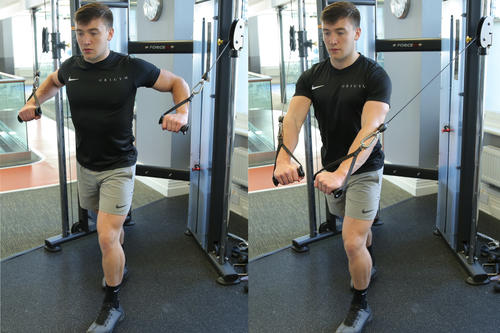
Decline Cable Chest Press (Seated)
The decline cable press or decline cable bench press as its also referred can be performed in a seated position in two ways:
1st Method:
Set Up: Place the bench in the middle of the cable machine and pulleys placed on the lowest point on each side. Put the bench at a 30-degree decline angle.
Starting Position:
- Lie flat on the bench, with feet flat on the floor or you can use a sit-up bench to help lower you into position and keeping yourself stable
- Grab the stirrups from both sides with a supine grip and bring your hands to just below chest.
- Place a 90-degree bend in your elbows with your knuckles pointing towards the ceiling as you grip the handles.
Execution:
- Push through your elbows towards the ceiling and inwards.
- Squeeze at the top of the movement and slowly release back to the original starting position before repeating the movement.
2nd Method
Set Up – Place a bench in between the chest press or cable crossover machine with a bench placed in the middle in an upright position. Set the stirrups to be around chest height on either side.
Starting Position:
- With feet at shoulder width apart and firmly flat on the floor, grip the stirrups in the supine position on either side and bring them in towards your lower chest and upper part of your stomach.
- Again, keep elbows at a 90-degree angle to your body
Execution:
- With your head facing forward and core engaged drive out from your elbows forward, down and in, until your hands meet in front of your lower midriff.
- Hold the movement, for a count of two before, taking a big breath in as you lower back to the starting position.
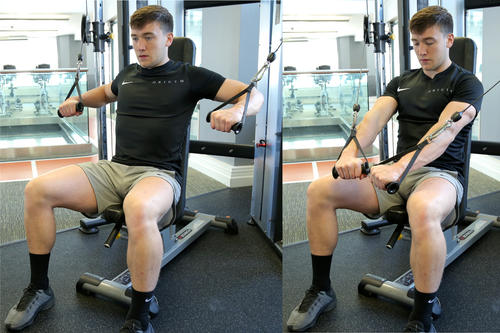
Muscles worked:
Prime Mover: pectoralis major (chest)
Secondary Muscle: Anterior Deltoid (front of the shoulder, Triceps brachii (back of the arm)
Conclusion
That’s all the variations to the cable chest press. Compliment and mix up your chest routine with these movements to round your workouts and give you some diversity.
Take a look at our L3 PT Diploma or download our FREE prospectus here to get a taste of what you could be learning!
Start a Successful Online PT Business From Home in 9 Weeks!
Get started by downloading our video guide
Enquire to Become a Personal Trainer
Follow your passion for fitness and enquire to start a career in soemthing you truly care about!
